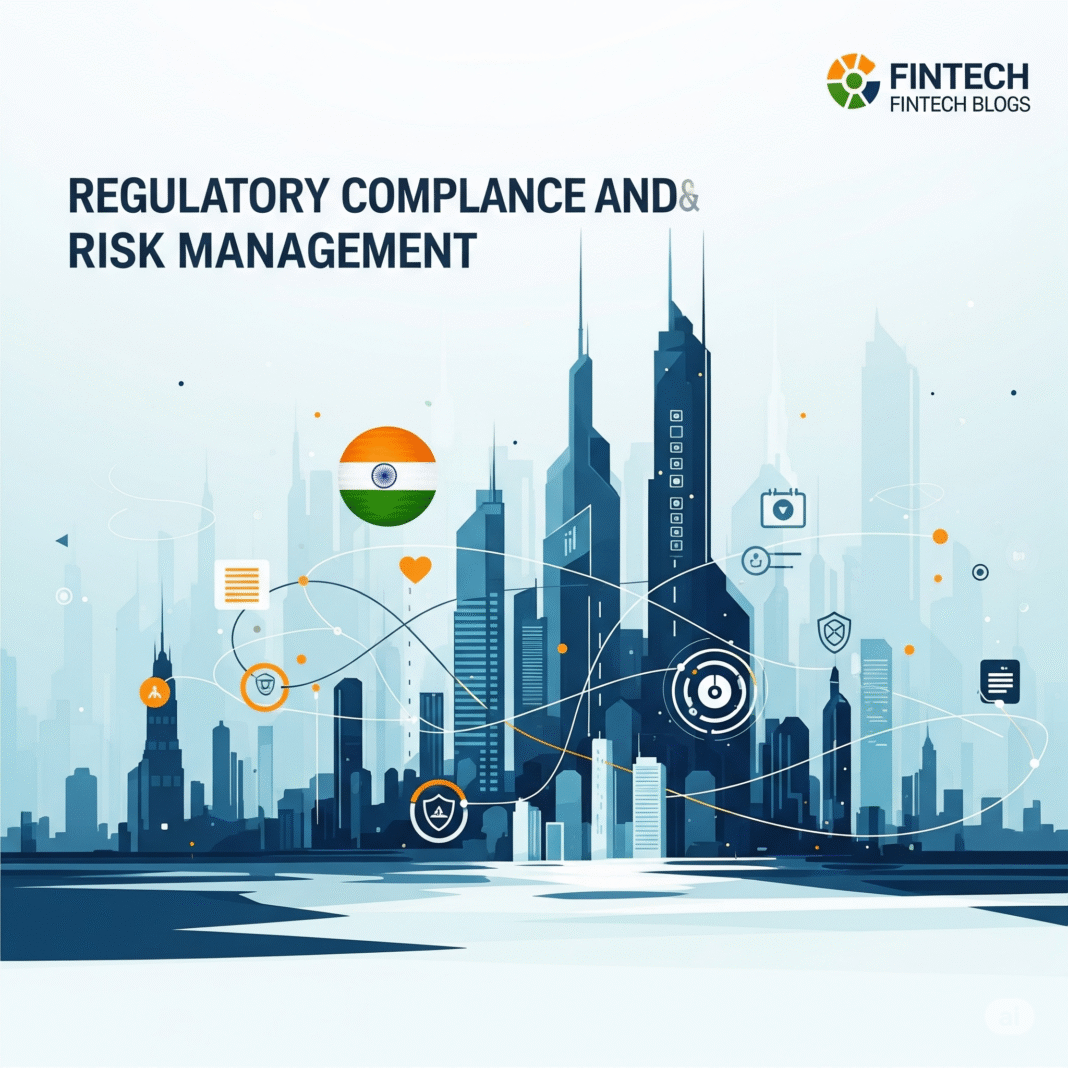The Digital Gold Rush: Striking a Balance Between Innovation and Security
India’s fintech landscape is nothing short of a phenomenon. From the ubiquitous reach of UPI enabling seamless transactions for millions, to the rapid ascent of digital lending platforms democratizing access to credit, we are witnessing a digital gold rush. This innovation surge, while empowering, brings with it a unique set of challenges – primarily, the ever-growing need for robust regulatory compliance and sophisticated risk management. It’s a delicate dance, where the rhythm of technological advancement must harmonize with the steady beat of security and trust. Imagine a bustling digital marketplace where every transaction, every loan application, every piece of personal data needs to be safeguarded with an ironclad resolve. This isn’t just about adhering to rules; it’s about building a sustainable, trustworthy ecosystem where innovation can flourish without compromising the integrity of the financial system or the privacy of its users. The stakes are incredibly high, as India aims to solidify its position as a global leader in financial technology. Let’s delve into how Indian fintech companies are not just responding to these challenges but are actively shaping a future where security and compliance are inherent to the very fabric of digital finance.
The Regulatory Landscape: A Maturing Ecosystem
India’s fintech sector has matured at an astonishing pace, and with that growth comes a more sophisticated regulatory framework. The Reserve Bank of India (RBI) has been particularly active, rolling out guidelines for digital lending, payment aggregators, and data localization. This isn’t about stifling innovation; rather, it’s about providing a clear rulebook for fair play and consumer protection. Think of it like building a superhighway for financial transactions – you need clear lanes, speed limits, and traffic lights to ensure smooth and safe passage for everyone. Companies are now investing heavily in dedicated compliance teams, leveraging RegTech (Regulatory Technology) solutions to automate adherence to complex regulations, and engaging in continuous dialogue with regulatory bodies. This proactive approach helps them stay ahead of the curve, anticipating future mandates rather than merely reacting to past ones. The goal is to create a predictable environment where businesses can innovate confidently, knowing the boundaries.
Combating Fraud in the Digital Realm: A Multi-pronged Approach
The sheer volume of digital transactions, especially through UPI, presents a fertile ground for fraudsters. From phishing scams targeting unsuspecting users to sophisticated identity theft rings, the threats are constant and evolving. Indian fintech companies are fighting back with a multi-pronged strategy. This involves the deployment of advanced AI and machine learning algorithms that can detect unusual transaction patterns in real-time, flagging suspicious activities before they escalate. Behavioral biometrics are also gaining traction, analyzing how a user interacts with their device to verify identity beyond traditional passwords. Furthermore, collaborations between financial institutions, law enforcement, and industry bodies are crucial for sharing threat intelligence and coordinating responses. It’s a collective defense, much like an immune system working to protect the entire body. The aim is to make the digital payment ecosystem a fortress against illicit activities, ensuring users can transact with peace of mind.
Data Privacy: The Cornerstone of Trust
In an increasingly data-driven world, safeguarding personal information is paramount. The absence of a comprehensive data protection law in India for a long time created a vacuum, but companies have largely adopted best practices in anticipation of future regulations. The recent push towards a robust data protection framework emphasizes consent, data minimization, and the right to be forgotten. Fintech firms, dealing with highly sensitive financial data, are at the forefront of implementing these principles. This means robust encryption protocols, secure data storage solutions, and stringent access controls. Imagine a vault where every piece of sensitive information is not only locked away but also meticulously cataloged and accessible only to authorized personnel. Beyond technical measures, there’s a growing emphasis on transparent data usage policies, educating users about how their data is collected, used, and shared. Building this trust is not just a compliance requirement; it’s a fundamental pillar for long-term customer loyalty and sustained growth in the digital financial space.
The Rise of RegTech and SupTech: Technology as an Enabler
The complexity of modern financial regulations and the scale of digital operations necessitate technological solutions. This is where RegTech (Regulatory Technology) and SupTech (Supervisory Technology) come into play. RegTech solutions help fintech companies automate compliance processes, monitor transactions for suspicious activity, and generate regulatory reports efficiently. This reduces manual errors, saves costs, and ensures timely adherence to diverse regulations. For instance, AI-powered tools can analyze vast amounts of data to identify potential money laundering patterns or assess creditworthiness while adhering to lending guidelines. On the other hand, SupTech refers to technologies used by regulatory bodies to enhance their oversight capabilities. This could involve using AI to analyze market trends, identify systemic risks, or even conduct automated compliance checks on regulated entities. It’s a digital arms race, but one that ultimately benefits the consumer by creating a more secure and transparent financial system. These technologies are no longer optional but essential for survival and success in India’s highly regulated fintech arena.

Credit Risk Management in Digital Lending: Beyond Traditional Models
Digital lending has opened up credit access to segments previously underserved by traditional banks. However, this accessibility comes with increased credit risk, especially when dealing with new-to-credit customers or those with informal income streams. Fintech lenders are innovating beyond conventional credit scoring models, incorporating alternative data points such as utility bill payments, mobile recharge patterns, and even social media activity (with explicit consent, of course) to build a more holistic borrower profile. Machine learning models are crucial here, sifting through vast datasets to identify subtle indicators of creditworthiness and potential default. Furthermore, robust loan origination systems, automated underwriting processes, and proactive collection strategies are vital. It’s about finely tuning the balance between responsible lending and expanding financial inclusion. This requires constant refinement of algorithms, continuous monitoring of loan portfolios, and a willingness to adapt to new risk indicators as the market evolves. The goal is not just to lend, but to lend responsibly, ensuring both the borrower’s well-being and the lender’s financial health.
Cybersecurity: The Perpetual Battleground
Beyond fraud detection, cybersecurity remains a perennial concern. Fintech companies are prime targets for cyberattacks due to the sensitive nature of the data they handle and the financial transactions they facilitate. Distributed Denial of Service (DDoS) attacks, ransomware, and sophisticated hacking attempts are constant threats. Therefore, a multi-layered cybersecurity strategy is indispensable. This includes strong firewalls, intrusion detection systems, regular penetration testing, and employee training on cybersecurity best practices. Think of it as a digital fortress with multiple walls, moats, and guards. Furthermore, incident response plans are crucial, ensuring that in the event of a breach, the company can respond swiftly, mitigate damage, and restore normalcy while keeping customers informed. The battle for cybersecurity is continuous, requiring constant vigilance, investment in cutting-edge technologies, and a culture of security awareness embedded throughout the organization. Only with such diligence can the trust that underpins digital finance be maintained.
Consumer Protection and Redressal Mechanisms
While technology drives innovation, the human element – the consumer – remains at the heart of financial services. Ensuring robust consumer protection and efficient redressal mechanisms is a key aspect of regulatory compliance. This includes transparent terms and conditions for financial products, clear communication about charges and interest rates, and easily accessible channels for grievance redressal. The RBI’s integrated ombudsman scheme and other industry-led initiatives aim to provide consumers with avenues to resolve disputes swiftly and fairly. For fintech companies, this means investing in customer service, building intuitive user interfaces that promote transparency, and proactively addressing customer concerns. It’s about fostering an environment where consumers feel empowered and protected, knowing that their rights are upheld and their voices heard. This goes beyond mere compliance; it’s about building long-term relationships based on trust and mutual respect, which is crucial for the sustainable growth of the Indian fintech ecosystem.
Looking Ahead: A Collaborative Future
The journey of regulatory compliance and risk management in Indian fintech is dynamic and evolving. The future will likely see even greater collaboration between regulators, fintech companies, and traditional financial institutions. Sandboxes and innovation hubs promoted by the RBI and other government bodies will continue to provide a safe space for testing new products and services under regulatory supervision, fostering innovation while managing risks. Furthermore, there will be an increasing focus on international best practices and harmonization of regulations as Indian fintech aims for global expansion. The goal is to strike a delicate balance: fostering an environment that encourages groundbreaking innovation while simultaneously building an impenetrable shield of security, compliance, and trust. This collaborative spirit, coupled with a commitment to continuous improvement in risk management and regulatory adherence, will be the bedrock upon which India’s fintech leadership will be built, ensuring a secure and prosperous digital financial future for all its citizens.

Conclusion: Forging a Resilient Future for Indian Fintech
India’s fintech sector stands at an exhilarating crossroads, propelled by unprecedented digital adoption and a vibrant spirit of innovation. Yet, the path forward is not without its intricate challenges, particularly in the realm of regulatory compliance and risk management. As we’ve explored, the journey from a nascent ecosystem to a global fintech powerhouse hinges critically on the ability of every player – from agile startups to established giants – to not only embrace but master these vital aspects. It’s about moving beyond mere box-ticking and embedding a culture of security, transparency, and responsibility into the very DNA of every digital product and service. The proactive stance of the RBI, coupled with the industry’s growing adoption of cutting-edge RegTech and SupTech solutions, is creating a formidable defense against fraud and cyber threats while ensuring consumer data remains sacrosanct. This isn’t just about adhering to rules; it’s about building a robust, trustworthy foundation that can withstand the tests of time and scale. By prioritizing consumer protection, fostering collaborative intelligence-sharing, and continuously refining their risk frameworks, Indian fintech companies are not just navigating the labyrinth – they are actively mapping it, forging a resilient and sustainable future where innovation thrives hand-in-hand with integrity. The digital finance revolution in India is not just about speed and access; it’s increasingly about safety, trust, and a secure future for every single user.
Frequently Asked Questions (FAQs)
What exactly is regulatory compliance in the context of Indian fintech?
Regulatory compliance in Indian fintech refers to the adherence of financial technology companies to the laws, regulations, and guidelines set forth by regulatory bodies, primarily the Reserve Bank of India (RBI) and other government agencies. This includes mandates related to digital lending practices, payment gateway operations, Know Your Customer (KYC) norms, Anti-Money Laundering (AML) policies, data privacy, and consumer protection. It’s about ensuring that all operations are conducted legally, ethically, and in a manner that protects consumers and maintains the stability of the financial system. Compliance is dynamic, requiring continuous monitoring and adaptation to evolving regulations and market conditions, reflecting India’s fast-paced digital transformation.
Why is risk management so crucial for digital lending platforms in India?
Risk management is paramount for digital lending platforms due to the inherent risks associated with extending credit, especially to new-to-credit customers or those with informal incomes. Key risks include credit risk (borrowers defaulting on loans), operational risk (failures in internal processes or systems), cybersecurity risk (data breaches or hacking), and regulatory risk (non-compliance leading to penalties). Effective risk management involves robust credit scoring models that often leverage alternative data, stringent fraud detection mechanisms, secure data handling, and proactive collection strategies. Without strong risk management, these platforms could face significant financial losses, reputational damage, and regulatory sanctions, ultimately undermining consumer trust and market stability.
How is AI being used to enhance fraud detection in India’s UPI ecosystem?
AI and machine learning are revolutionizing fraud detection in the UPI ecosystem by enabling real-time analysis of vast transaction data. These technologies can identify anomalous patterns, such as unusually high transaction values for a user, frequent transactions to new beneficiaries, or transactions from unusual geographical locations, which might indicate fraudulent activity. AI models learn from historical data to predict and flag suspicious behaviors more accurately than traditional rule-based systems. They help in detecting phishing attempts, account takeovers, and identity theft by analyzing behavioral biometrics and transaction context, thereby significantly bolstering the security infrastructure of UPI and protecting millions of users from financial crime.
What role does data privacy play in maintaining trust in Indian fintech?
Data privacy is the cornerstone of trust in Indian fintech because financial transactions involve highly sensitive personal and financial information. Customers entrust fintech companies with their data, and any breach or misuse can severely erode confidence. Adhering to data privacy principles like consent, data minimization, secure storage, and transparency builds trust. It assures users that their information is collected, processed, and stored responsibly, only for legitimate purposes. As India moves towards a comprehensive data protection law, companies that prioritize data privacy will gain a significant competitive advantage, as trust is a critical differentiator in a market saturated with digital financial services.
What is RegTech and how is it impacting compliance in India?
RegTech, or Regulatory Technology, refers to the use of technology, often including AI, blockchain, and cloud computing, to help financial institutions and fintech companies comply with regulatory requirements more efficiently and effectively. In India, RegTech is significantly impacting compliance by automating tasks like KYC verification, AML monitoring, transaction surveillance, and regulatory reporting. This automation reduces manual errors, lowers operational costs, and ensures timely adherence to complex and evolving regulations. By providing real-time insights into compliance postures, RegTech solutions enable Indian fintechs to proactively manage risks and avoid penalties, fostering a more agile and compliant financial ecosystem.
How are fintech companies balancing innovation with regulatory demands?
Fintech companies in India are balancing innovation with regulatory demands by adopting a ‘compliance-by-design’ approach, integrating regulatory requirements into the very foundation of their product development. They often engage in early consultations with regulators, participate in regulatory sandboxes to test new products in a controlled environment, and invest in robust internal compliance frameworks and dedicated teams. This proactive engagement allows them to innovate responsibly, ensuring that new services and products meet regulatory standards from inception rather than facing retrospective challenges. It’s a continuous iterative process of co-creation and adaptation, ensuring that the pace of innovation does not outstrip the need for a secure and regulated environment.
What are the key challenges in managing credit risk for new-to-credit customers in India?
Managing credit risk for new-to-credit customers in India presents unique challenges due to the lack of traditional credit history. These customers often don’t have CIBIL scores or formal employment records. Fintech lenders overcome this by leveraging alternative data points such as utility bill payments, smartphone usage patterns, digital transaction history, and psychometric assessments (with consent and ethical considerations). The challenge lies in accurately assessing repayment capacity and willingness using these non-traditional data sources and building robust AI/ML models that can predict risk with high accuracy, while also ensuring fairness and preventing discriminatory lending practices.
How important is collaboration between fintechs and traditional banks for risk management?
Collaboration between fintechs and traditional banks is increasingly important for comprehensive risk management. Banks bring established risk frameworks, large customer bases, and deep regulatory experience, while fintechs offer agility, technological innovation, and a deeper understanding of digital-first customer segments. Collaborations can lead to shared threat intelligence for fraud detection, joint development of secure payment infrastructures, and co-creation of hybrid financial products that leverage the strengths of both entities. This synergy helps in creating a more robust and secure financial ecosystem, addressing systemic risks more effectively and enhancing overall consumer trust in digital financial services.
What are the implications of stricter data privacy norms for fintech marketing?
Stricter data privacy norms will have significant implications for fintech marketing, shifting the focus from broad, untargeted campaigns to more consent-driven and value-added engagement. Companies will need to be transparent about data collection and usage, obtain explicit consent for marketing communications, and offer users greater control over their data. This will necessitate more personalized marketing based on consented data, emphasizing the utility and benefits of financial products rather than intrusive targeting. It will also drive innovation in privacy-preserving marketing techniques, building trust by respecting user choices and ensuring that marketing efforts align with ethical data practices.
How does continuous monitoring contribute to effective risk management in fintech?
Continuous monitoring is fundamental to effective risk management in fintech because the digital landscape is constantly evolving, with new threats and vulnerabilities emerging regularly. It involves real-time surveillance of transactions, network activity, system performance, and customer behavior to detect anomalies, potential fraud, and cyber threats instantly. This proactive approach allows companies to identify and respond to risks before they escalate, minimizing potential losses and disruption. Continuous monitoring, powered by advanced analytics and AI, ensures that security protocols and risk frameworks remain robust and adaptable, providing an ongoing shield against emerging threats in the dynamic fintech environment.
